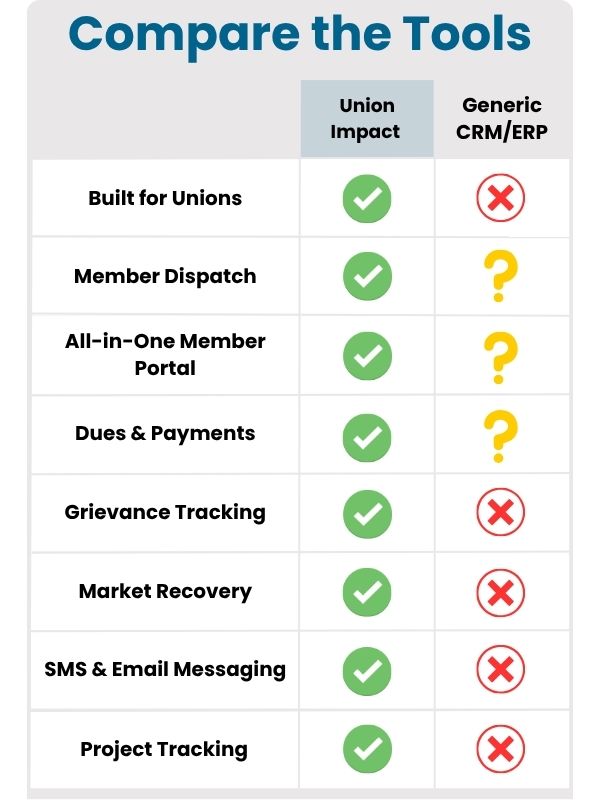From Compliance to Commitment:
Rethinking Member Voice in Union Workplaces
1. “Members are the union” — but do they feel that way?
Most of us in the labor movement say it all the time:
“Members are the union.”
We put it on t‑shirts, banners, and speeches. But if we’re honest, a lot of members don’t experience it that way.
From their side, it can look like this:
They get occasional emails, texts, or a newsletter
They’re asked to fill out a bargaining survey every few years
Maybe they’re invited to a big meeting or town hall
Then leadership disappears into bargaining, grievances, or strategy work behind closed doors
That’s engagement as broadcast — information flowing out from the union — not voice, where information and power can actually flow both ways.
We don’t just have a turnout problem.
We have a member voice problem.
Members and other workers already have plenty to say. They talk on breaks, in group chats, in DMs with stewards, in side conversations after meetings. When they feel like formal channels don’t work, they go around them — to social media, the press, or even directly to management.
Unions that will grow and win in the next decade aren’t the ones that “manage” member voice as a risk. They’re the ones that build structures to harness it — for better contracts, stronger campaigns, and more democratic unions.

Serving American Locals: Our platform is built to support unions across the United States, with U.S. locals operating on our U.S.-based systems to keep everything aligned with domestic operations and member needs.

Serving Canadian Locals: Canadian unions are supported through dedicated Canadian infrastructure, ensuring your local’s data, workflows, and member services remain inside Canada—built for Canadian unions, by a team that supports them every day.
2. Member engagement vs. member voice
These two ideas sound similar, but they’re not the same.
Member engagement is about how connected people feel to the union.
Do they show up? Do they read the messages? Do they vote?Member voice is about whether they can say what they really think — and see it actually shape what the union does.
You can have:
High engagement, low voice
Members turn out for actions or votes but feel like decisions are already made.Low engagement, high voice
A smaller core of members and activists has real influence, but the wider base is checked out.Low engagement, low voice
The “we only see you at dues time” union experience.High engagement, high voice
Members feel informed, involved, and able to disagree without being shut down.
Most unions measure the first (engagement) — turnout, open rates, survey responses — and underinvest in the second (voice).
If we care about building real power, we need both.
3. Why the old tools aren’t enough anymore
Traditional union communication and input tools look something like this:
A newsletter or email blast
A big bargaining survey every few years
A membership meeting that’s hard for many people to attend
Grievance processes that feel like a black box
Suggestion forms that disappear into a void
None of these are bad. But on their own, they struggle in today’s reality:
They’re too slow.
Shop floor issues move in days or weeks. A once‑a‑year survey or rare general meeting can’t keep up.They feel one‑way.
Members speak up, then never hear what happened with their input. The next time, they don’t bother.They can feel risky.
If people worry about retaliation — from management or internally — they won’t say what they really think in open meetings.They compete with informal channels.
Group chats, Discord servers, and social media let people air their views instantly. If the union’s formal channels don’t work, members will default to those.
The result: leaders may feel like “no one is giving feedback,” while members feel like “no one is listening.”

Our platform is hosted only in SOC 2 Type II / SOC 3 Type II–audited data centers, giving you a proven compliance baseline from day one.
Nightly Off-Site Backups
Your data is backed up automatically every night to a separate, secure data center—so you’re protected from accidental loss or hardware failures.
Security You Can Trust
Your connection to our system is encrypted with HTTPS (SSL/TLS) using 2048-bit certificates, ensuring your data stays private and tamper-resistant in transit.

Dedicated Infrastructure: Your security is our priority. Every client receives their own dedicated server, meaning your data is never co-mingled with anyone else’s. This private environment ensures maximum security and performance.
Choose a reliable partner that follows the latest security protocols.
4. Member voice across the union–management line
Member voice isn’t just about internal union democracy. It’s also a huge asset in how we deal with management.
Members see:
Safety issues before they become disasters
Workload and staffing problems before they become crises
Which policies matter most day‑to‑day
What’s actually happening with supervisors on the ground
When member voice is weak:
Grievances pile up late and messy
Bargaining demands are generic or disconnected from real pain points
Leaders are constantly in “firefighting mode”
When member voice is strong:
Stewards and leaders get early warning on issues
Bargaining priorities are grounded in real lived experience
Management can’t divide and conquer as easily, because the union’s internal conversations are deeper and more real
That doesn’t mean there’s no conflict. It means we’re using conflict productively — to grow power and win better outcomes, not just to vent.
5. Building a real member voice system
So what does it look like to move from ad‑hoc feedback to a system for member voice? Four pillars:
5.1 Multiple channels, one backbone
Different members are comfortable in different spaces. A healthy union has:
In‑person channels
Shop visits, steward check‑ins, small group conversations, caucus and committee meetings.Digital channels
Surveys, WhatsApp/Signal/Slack groups, online forms, text replies.Formal channels
General membership meetings, contract surveys, official consultations.
The key is to connect all of this into one listening backbone so:
Patterns are tracked (not just individual complaints)
Insights can move from steward → staff → leadership → bargaining / campaigns
No one person is the only “holder” of critical information
Somebody needs clear responsibility for turning “lots of input” into “clear themes and next steps.”
5.2 Clarity on what is and isn’t on the table
Nothing kills trust faster than asking for input on things you secretly know you can’t change.
Be explicit with members about:
What’s in scope: what the union can realistically bargain over, fix internally, or escalate.
What’s constrained: legal limits, contract language, employer financials, or timelines you don’t fully control (yet).
A simple four‑step pattern helps:
You said – summarize what members actually raised.
We can – what the union can act on now.
We can’t (yet) – what’s blocked and why.
We will review – what needs more info, testing, or organizing.
Being honest about constraints builds more trust than vague promises.
5.3 Close the loop — visibly
Member voice doesn’t fail because people don’t care. It fails because people stop believing anything will change.
So after you collect input:
Share back the top themes in simple language
Name at least a few concrete changes or actions
Clearly explain why some things aren’t changing right now
Even small wins matter:
“Because members raised X, we changed Y.”
“We heard Z from multiple worksites, so we’re making it a priority in bargaining.”
Over time, members stop judging you by how many surveys you send and start judging you by your pattern of follow‑through.
5.4 Protect the messengers
Member voice relies on people who are willing to speak up: stewards, activists, outspoken members, new leaders.
If those people get punished or sidelined — by management or internally — everyone sees it.
Practically, that means:
Backing up stewards and members when they raise uncomfortable truths
Not labeling people as “negative” or “difficult” just because they disagree
Focusing on fixing systems and conditions, not just blaming individuals
Psychological safety isn’t a buzzword; it’s culture plus enforcement. People need to know: “If I speak up in good faith, the union has my back.”

Data Sovereignty Guaranteed: We are a U.S.-based company and store all American client data on servers within the United States.

To meet Canadian privacy laws: All Canadian client data is hosted exclusively in Canadian data centers.

For nearly two decades, we’ve been a trusted partner to union halls across North America.
Since 2006, our hands-on experience has given us a deep understanding of the unique challenges you face. We are proud to provide powerful, tailored solutions that solve those challenges and make a real impact on your operations.
6. Getting started: a simple roadmap
You don’t need a huge new project. Start small and real.
Ask members how they experience voice right now.
In 1:1s or quick conversations, ask:“When you have a concern, what do you usually do?”
“What’s one time you felt heard by the union?”
“What’s one time you felt ignored?”
Pick one priority area to improve.
It could be: contract input, safety issues, scheduling, or internal racism/harassment. Don’t try to fix everything at once.Design the full loop before launching anything.
Before you send a survey or hold a listening session, decide:Who will read and sort the input?
How will decisions be made?
When and how will you report back?
Build a small joint team.
Include stewards, rank‑and‑file members, and maybe a staffer or officer. Give them a clear mandate: “Make it easier and safer for members to be heard on X, and bring us 2–3 concrete changes.”Track and share progress.
Simple metrics: how many members participated, what changed, what’s next. Report back more than once so people see a pattern.
7. From compliance to commitment
A lot of organizations — including unions — treat “listening to members” as a compliance task:
Did we do a survey?
Did we hold a meeting?
Can we say we consulted people?
That’s the floor, not the ceiling.
The next step is treating member voice as a source of power and direction:
Power in bargaining, because your demands are grounded in real lived experience
Power in campaigns, because members helped shape the strategy
Power inside the union, because people see themselves as co‑owners, not customers
When members believe their voice matters, everything changes:
More people take on roles and responsibilities
Conflicts become chances to clarify values and direction
Trust grows — not because everything is perfect, but because people can see how decisions get made
“Members are the union” becomes less of a slogan and more of a daily practice.
And that’s the kind of union culture that not only survives the next decade, but actually grows.

Union Impact was founded on one principle: unions deserve software designed for them—not retrofitted business tools. By handling migration, integrating core modules, and focusing on compliance and transparency, Union Impact gives locals the tools to stay organized, retain members, and grow.
To hear directly from locals using our platform, see Union Client Testimonials.












